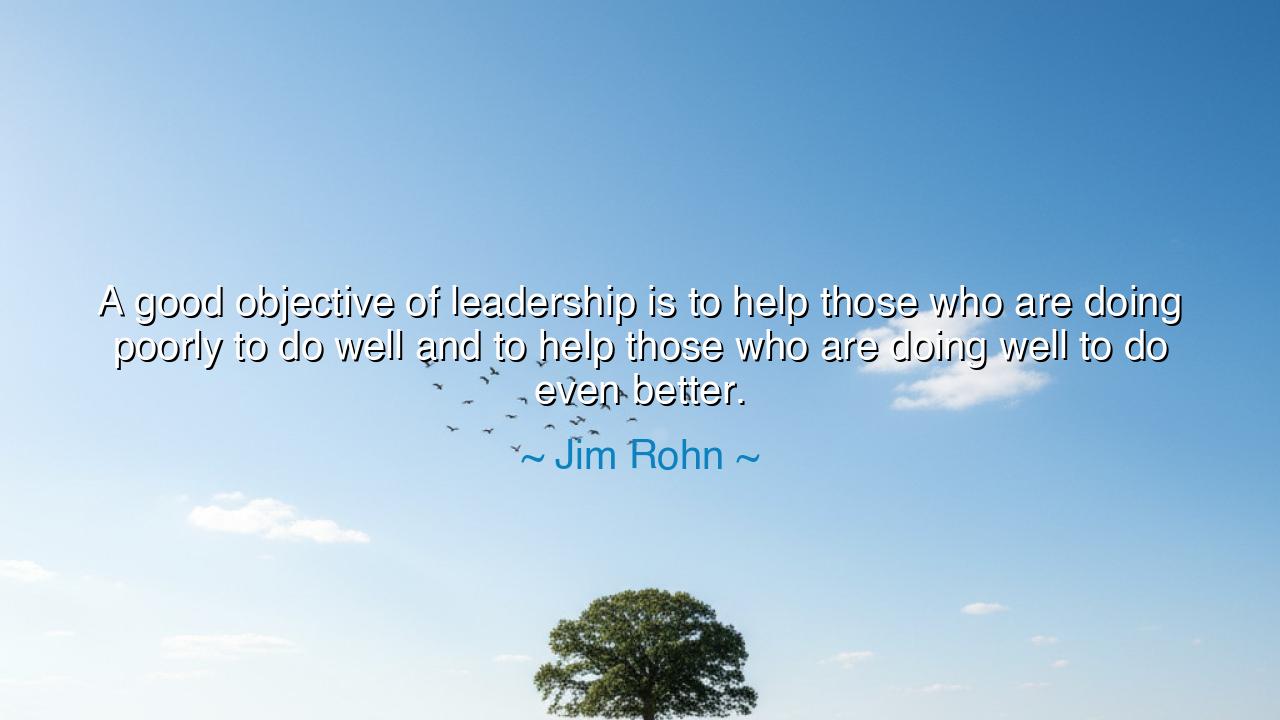
A good objective of leadership is to help those who are doing
A good objective of leadership is to help those who are doing poorly to do well and to help those who are doing well to do even better.






“A good objective of leadership is to help those who are doing poorly to do well and to help those who are doing well to do even better.” – Jim Rohn
In these noble and timeless words, Jim Rohn, the philosopher of personal development, speaks to the very heart of true leadership—a calling not of command, but of cultivation. Leadership, in its highest form, is the art of upliftment. It is the gentle hand that steadies the weak and the guiding flame that pushes the capable toward greatness. Rohn reminds us that a leader’s duty is not to rule, but to raise—to look upon the struggling with compassion and upon the successful with challenge, ensuring that all continue to grow. For the true measure of leadership lies not in one’s own success, but in the flourishing of those who follow.
The meaning of this quote lies in balance—the harmony between care and ambition, between mercy and excellence. A leader who helps only the strong becomes an elitist, and one who helps only the weak becomes a rescuer; but a leader who helps both fulfills the divine rhythm of growth that governs all life. In this way, leadership mirrors the sun: it warms the seed hidden beneath the soil and nourishes the towering tree alike. To help those “doing poorly to do well” is an act of service; to help those “doing well to do even better” is an act of vision. Together, they form the complete circle of stewardship.
The origin of Rohn’s wisdom flows from his own life—a man born into humble circumstances who rose to become one of the most influential teachers of personal and professional growth. He knew from experience that leadership is not about hierarchy but humanity. He taught that the greatest leaders—whether in business, politics, or the family—are those who see potential where others see failure, and possibility where others see complacency. To Rohn, leadership was a sacred trust: to awaken the best in others, no matter their station or strength. His philosophy, simple yet profound, transcends time and culture—it speaks to the shepherd as much as to the king.
History offers a vivid embodiment of this truth in the life of George Washington, the father of a nation and a servant of his people. During the harsh winter at Valley Forge, when his soldiers were starving and near despair, Washington did not merely command from afar—he shared their suffering, walked among them, and spoke words of courage that revived the dying spirit of his army. He lifted the fallen to their feet and inspired the strong to push harder. He led by example, uniting both the weak and the strong in a single purpose. This is what Rohn describes: leadership as a bridge—one that connects every soul, regardless of rank or ability, to the possibility of greatness.
Yet, Rohn’s words also hold a warning. Leadership that neglects either end of the spectrum—the struggling or the thriving—becomes unbalanced. If a leader focuses only on the weakest, the strong grow idle and lose their edge; if attention is given only to the high achievers, resentment and despair spread among the rest. True leadership demands discernment and empathy: to know when to comfort and when to challenge, when to nurture and when to demand. For in every human being lies a spark that can be fanned into flame, if only someone believes in it and gives it air to burn.
This wisdom is not confined to nations or companies—it applies to the home, the classroom, the workshop, the temple. A parent is a leader when they encourage a struggling child to persevere and challenge a gifted one to reach higher. A teacher is a leader when they lift the timid voice of the uncertain student while pushing the confident one to refine their craft. Leadership, then, is not an office, but a spirit—a way of seeing the world that asks not “How can I rise?” but “How can we rise together?”
And so, the lesson of Jim Rohn’s teaching is both practical and eternal: to lead is to serve growth. Wherever you stand—be it in the family, the workplace, or the community—seek out those who falter, and give them strength. Find those who flourish, and give them challenge. Do not measure success by how far you have gone, but by how many you have helped move forward. For when you lift others, you lift yourself. When you light another’s candle, your own flame burns brighter. The legacy of a great leader is not the throne they sat upon, but the multitude of lights they left shining in the world.
Thus, let us remember the sacred balance of leadership: to help the weak rise and the strong soar, to kindle courage where there is fear and purpose where there is comfort. For as Jim Rohn teaches, the truest objective of leadership is not domination—it is transformation. And in helping others become their best, we fulfill the highest calling of our own humanity.






AAdministratorAdministrator
Welcome, honored guests. Please leave a comment, we will respond soon